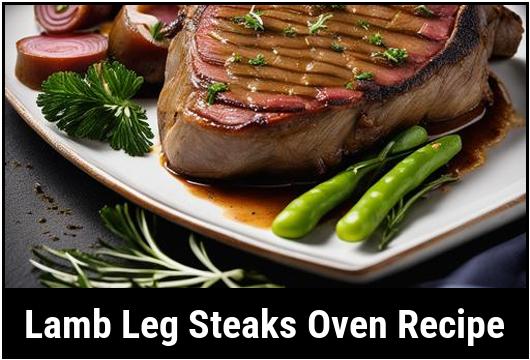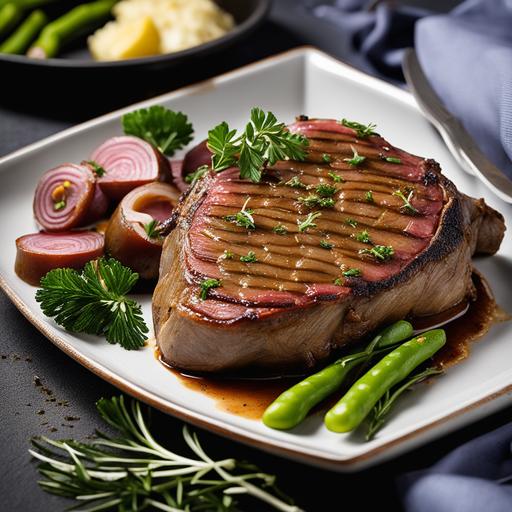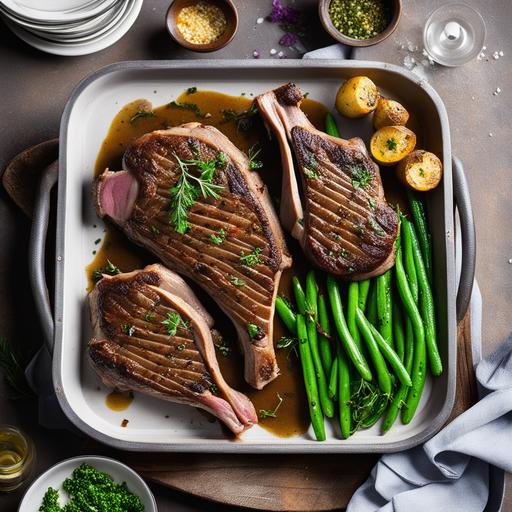
The Exquisite Art Of Cooking Lamb Leg Steaks In The Oven
When it comes to indulging in succulent and flavorful meat, few cuts can match the taste and tenderness of lamb leg steaks. Cooking these delectable steaks in the oven is a time-honored tradition that is guaranteed to impress. In this comprehensive guide, we will explore the ins and outs of preparing lamb leg steaks in the oven. From understanding the food science behind the cooking process to providing in-depth culinary details, cleaning, preparation, tips, variations, doneness checks, and even handling the risks of overcooking or undercooking, we have you covered.
I. Understanding the Food Science
1. The Anatomy of Lamb Leg Steaks
Before diving into the cooking process, it’s essential to familiarize ourselves with the anatomy of lamb leg steaks. These steaks are cut from the upper portion of the rear leg, known as the leg roast. The leg roast is known for its well-exercised muscles, which contributes to the meat’s distinct flavor and texture. To ensure optimal tenderness, proper cooking techniques are crucial.
2. The Maillard Reaction – Unlocking Flavor
The Maillard reaction is a crucial chemical process that occurs when cooking lamb leg steaks in the oven. This reaction, which involves the browning of proteins, sugars, and amino acids, results in the desirable taste and aroma we associate with perfectly cooked meat. By understanding this reaction, we can make informed decisions during the cooking process to enhance flavor and texture.
II. Culinary Details
1. Selecting the Perfect Lamb Leg Steaks
Choose quality lamb leg steaks from a reputable source. Look for steaks that have a vibrant pinkish-red color and are well-marbled with fat. The fat should be evenly distributed, as this will contribute to the tenderness and juiciness of the final dish. Avoid steaks with a pungent smell or a dull, grayish color, as these are signs of poor quality.
2. Cleaning and Preparing the Steaks
Start by rinsing the lamb leg steaks under cold running water to remove any excess brine or blood. Pat them dry gently using paper towels. Next, trim any excess fat or silver skin from the steaks. While fat adds flavor, excessive amounts can lead to a greasy end result.
3. Marinating – The Flavor Enhancement Technique
Marinating lamb leg steaks adds an extra dimension of flavor and helps tenderize the meat. Create a marinade of your choice by combining herbs, spices, oil, and acidic ingredients such as lemon juice or vinegar. Allow the steaks to marinate for at least 2 hours, but preferably overnight, in the refrigerator. This step is optional but highly recommended for a truly exceptional dining experience.
4. Seasoning – Elevating Taste
Just before cooking, season the lamb leg steaks generously with salt and pepper to enhance the natural flavors. You may choose to add additional herbs and spices according to your preference, such as rosemary, thyme, or garlic powder.
III. Cooking Techniques

1. Oven Preheating and Setting
Preheating the oven is a vital step to ensure even cooking and consistent results. Set the oven to 350°F (175°C) for a moderate heat that will gently cook the lamb leg steaks.
2. Pan Searing – The First Step towards Perfection
Before placing the lamb leg steaks in the oven, pan searing creates a delectable golden crust on the outside. Heat a skillet over medium-high heat and add a small amount of oil or butter. Sear the steaks for approximately 2 minutes on each side until they develop a beautiful caramelized exterior.
3. Oven Roasting – The Key to Tender Perfection
Transfer the seared lamb leg steaks to a preheated oven-safe dish or a baking sheet lined with a wire rack. Place the dish in the preheated oven and allow the steaks to roast for about 15-20 minutes per pound (450 grams) for medium-rare doneness, or 20-25 minutes per pound for medium doneness. This cooking time may vary based on the thickness of the steaks and desired level of doneness.
4. Doneness Checks – Ensuring Perfection
Properly checking the doneness during cooking is crucial to achieving the desired level of juiciness and tenderness. Meat thermometers are the most accurate tool for this purpose. For medium-rare, aim for an internal temperature of 135°F (57°C), while medium requires a temperature of 145°F (63°C). Remember to insert the thermometer into the thickest part of the steak without touching the bone for accurate results. If you prefer well-done, a temperature of 160°F (71°C) is recommended.
IV. Tips and Variations

1. Resting – The Final Touch
Once your lamb leg steaks have reached the desired level of doneness, remove them from the oven and tent them with aluminum foil. Allow the steaks to rest for approximately 10 minutes before serving. Resting allows the juices to redistribute within the meat, resulting in a more succulent eating experience.
2. Serving Suggestions – Pairing Flavors
Lamb leg steaks are incredibly versatile and pair well with a range of flavors. Consider serving them alongside garlic mashed potatoes, roasted seasonal vegetables, or creamy cauliflower puree. A red wine reduction or herb-infused oil drizzled over the steaks can further enhance their flavors.
3. Flavorful Variations
While lamb leg steaks shine on their own, experimenting with different flavor profiles can elevate your culinary experience. Consider marinating the steaks with a combination of Asian-inspired ingredients, such as ginger, soy sauce, and sesame oil. Alternatively, spice things up with a blend of cumin, paprika, and cayenne pepper for a Moroccan-inspired twist.
V. Avoiding Overcooking and Undercooking

1. Risks of Overcooking – The Perils
Overcooking lamb leg steaks can result in a dry and tough texture that fails to do justice to this delightful cut. To avoid this, ensure you monitor the cooking time diligently and use a meat thermometer to reach the desired level of doneness accurately.
2. Risks of Undercooking – The Dangers
While some prefer their lamb leg steaks rare or medium-rare, undercooking does pose risks associated with pathogens like E. Coli and Salmonella. It’s essential to ensure the lamb leg steaks reach a safe minimum internal temperature to prevent foodborne illnesses. If you are concerned about the risks, aiming for medium doneness is recommended.
VI. Conclusion
Cooking lamb leg steaks in the oven is an exquisite culinary endeavor that promises to dazzle your taste buds. By understanding the food science, mastering culinary techniques, and utilizing the tips and variations provided, you can create a masterpiece on your plate. Remember to choose quality cuts, prepare them with care, and check for doneness to achieve the perfect balance of tenderness and flavor. With this comprehensive guide in hand, embark on your lamb leg steak cooking journey and savor the sumptuous results.
Sources
FAQS On Lamb Leg Steaks Oven Recipe
What Are The Ingredients Needed For Lamb Leg Steaks In The Oven?
You will need 4 lamb leg steaks, 2 tablespoons of olive oil, 2 cloves of garlic (minced), 1 tablespoon of rosemary (chopped), salt and pepper to taste.
How Should I Prepare The Lamb Leg Steaks Before Cooking Them In The Oven?
Before cooking the lamb leg steaks in the oven, make sure to pat them dry with paper towels and let them come to room temperature. This will help the steaks cook evenly and ensure a delicious flavor.
What Is The Recommended Cooking Temperature And Time For Lamb Leg Steaks In The Oven?
Preheat your oven to 375°F (190°C). Place the prepared lamb leg steaks on a roasting pan and cook for about 25-30 minutes for medium-rare or 30-35 minutes for medium, turning them halfway through the cooking time.
How Do I Know If The Lamb Leg Steaks Are Cooked To Perfection?
To ensure the lamb leg steaks are cooked to your desired level of doneness, use a meat thermometer to check the internal temperature. For medium-rare, the thermometer should read 145°F (63°C) and for medium, it should read 160°F (71°C).
What Are Some Recommended Side Dishes To Serve With Lamb Leg Steaks Cooked In The Oven?
You can pair your lamb leg steaks with roasted vegetables such as potatoes, carrots, and Brussels sprouts. A fresh salad or some crusty bread would also make great accompaniments to this delicious dish.


